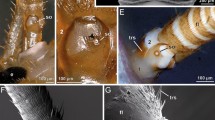Summary
The proprioceptors of the musculature moving the second antennal segment in the collembolan Allacma fusca were examined with the electron microscope. There are five muscles, the most important of which appear to be a levator and a depressor muscle. Only these two muscles are monitored by proprioceptors. These proprioceptors, the scolopidia, are referred to here as the levator (l-) and the depressor (d-) scolopidium. The former contains two, the latter one sensory cell.
Both scolopidia deviate from the usual pattern in that they have unmodified dendritic outer segments (no dilatations, no electron-dense material) and are enveloped by only one cell. But l- and d-scolopidia also differ from one another. The dendritic inner segments of the l-scolopidium are branched to an h-shaped pattern, with one branch ending on the levator muscle and the other running to the antennal nerve where the perikarya are located. In the d-scolopidium a muscle fiber of about 1 μm diameter (140–320 myosin filaments) accompanies the scolopidium for a distance of about 0.5 μm.
On the basis of the structural features it is hypothesized that (1) the mechanical forces possibly act on the membranes of the dendritic inner segments, (2) the small muscle parallel to the d-scolopidium is a receptor muscle, and (3) both scolopidia are highly derivative.
Similar content being viewed by others
References
Alexandrowicz JS (1951) Muscle receptor organs in the abdomen of Homarus vulgaris and Palinurus vulgaris. Q J Microsc Sci 92:163–199
Alexandrowicz JS, Whitear M (1957) Receptor elements in the coxal region of decapode Crustacea. J Mar Biol Ass UK 36:603–628
Altner H, Hintzpeter U (1984) Reduction of sensory cells in antennal sensilla correlated with changes in feeding behavior in the beetle Loricera pilicornis (Insecta, Coleoptera, Carabidae). Zoomorphology 104:171–179
Altner H, Thies G (1984) Internal proprioceptive organs of the distal antennal segments in Allacma fusca (L.) (Collembola: Sminthuridae): Proprioceptors phylogenetically derived from sensillum-bound exteroceptors. Int J Insect Morphol Embryol 13:315–330
Bräunig P, Hustert R (1985) Actions and interactions of proprioceptors of the locust hind leg coxo-trochanteral joint. I. Afferent responses in relation to joint position and movement. J Comp Physiol A 157:73–82
Bräunig P, Cahill MA, Hustert R (1986) The coxo-trochanteral muscle receptor organ of locusts. Cell Tissue Res 243:517–524
Finlayson LH (1976) Abdominal and thoracic receptors in insects, centipedes and scorpions. In: Mill PJ (ed) Structure and function of proprioceptors in the invertebrates. Chapman and Hall, London, pp 153–212
Fountain RL (1973) Motor control of accessory muscles in the tendon receptor organ in Limulus polyphemus. Comp Biochem Physiol 44A:511–517
Glauert AM (1974) Fixation, dehydration and embedding of biological specimens. In: Glauert AM (ed) Practical methods in electron microscopy, vol 3. North-Holland/American Elsevier, Amsterdam Oxford New York, pp 1–207
Imms AD (1939) On the antennal musculature in insects and other arthropods. Q J Microsc Sci NS 81:273–320
Komuro T (1981) Fine structural study of the abdominal muscle receptor organs of the crayfish (Procambarus clarkii). Sensory endings and synaptic structures. J Neurocytol 10:27–43
Moulins M (1976) Ultrastructure of chordotonal organs. In: Mill PJ (ed) Structure and function of proprioceptors in the invertebrates. Chapman and Hall, London, pp 387–426
Osborne MP (1963) An electron microscope study of an abdominal stretch receptor of the cockroach. J Insect Physiol 9:237–245
Osborne MP, Finlayson LH (1965) An electron microscope study of the stretch receptor of Antheraea pernyi (Lepidoptera, Saturniidae). J Insect Physiol 11:703–710
Paulus HF (1974) Erster Nachweis von Scolopalorganen in den Gliederantennen eines entognathen Insekts (Collembola, Symphypleona). Z Morphol Tiere 77:245–254
Schmidt K (1969) Der Feinbau der stiftführenden Sinnesorgane im Pedicellus der Florfliege Chrysopa Leach (Chrysopidae, Planipennia). Z Zellforsch 99:357–388
Schmidt K (1974) Die Mechanorezeptoren im Pedicellus der Eintagsfliegen (Insecta, Ephemeroptera). Z Morphol Tiere 78:193–220
Schmidt K (1975) Das Johnstonsche Organ der primär flügellosen Ectognatha (Lepisma, Zygentoma; Machilis, Archaeognatha). Cytobiologie 11:153–171
Tao-Cheng J-H, Hirosawa K, Nakajima Y (1981) Ultrastructure of the crayfish stretch receptor in relation to its function. J Comp Neurol 200:1–21
Author information
Authors and Affiliations
Additional information
Dedicated to Professor Dietrich Burkhardt on the occasion of his 60th birthday
Rights and permissions
About this article
Cite this article
Altner, H. The scolopidial organs in the first antennal segment in Allacma fusca (Collembola, Sminthuridae). Zoomorphology 108, 173–181 (1988). https://doi.org/10.1007/BF00363934
Received:
Issue Date:
DOI: https://doi.org/10.1007/BF00363934




